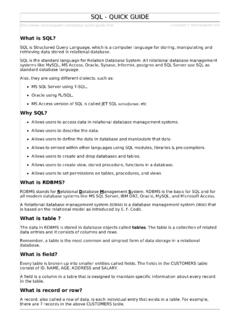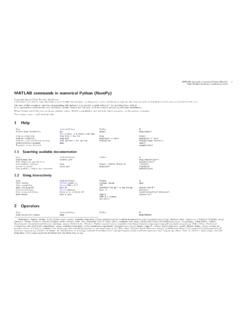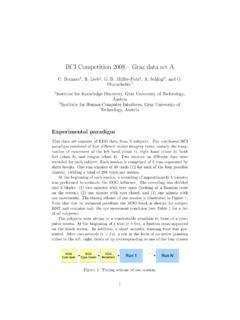Transcription of Using SQL Queries in Crystal Reports - pearsoncmg.com
1 46 0789731134 AppA 6/23/04 2:19 PM Page 819. APPENDIX. A. Using SQL Queries in Crystal Reports In this appendix Review of SQL Commands 820. An Introduction to SQL 820. 46 0789731134 AppA 6/23/04 2:19 PM Page 820. 820 Appendix A Using SQL Queries in Crystal Reports The SQL Commands feature was introduced in Chapter 1, Creating and Designing Basic Reports . For those users who are unfamiliar with SQL (Structured Query Language), this appendix serves as an introduction and helps enable the creation of SQL commands. For those users who are familiar with SQL, this appendix serves as a refresher with some impor- tant tips pertaining to the use of SQL with the new SQL Commands feature.
2 This chapter provides the following: A review of SQL Commands An introduction to SQL. A. Review of SQL Commands With Reports based on tables, views, or stored procedures, Crystal Reports does the back- ground work of generating a database query. This query incorporates the fields you have used in the report, any sorting or filtering you've applied, and even some calculations. This is one of the strengths of Crystal Reports you don't need to be an expert at writing SQL to use the product. All that complexity is abstracted away from the user designing the report. However, sometimes the person developing the report is familiar with the SQL language, and perhaps is also the database administrator.
3 In situations like this, people often want to write their own query for several reasons, including the following: An already defined query, which has the required fields, is in use elsewhere. The user wants to optimize her query beyond what Crystal Reports provides out-of- the-box. The user wants to perform a complex query that is beyond what Crystal Reports auto- matically generates; for example, a union query. The SQL Commands feature is meant to address these needs. Rather than adding a table or view to a report, you can add a SQL command. This command represents a SQL query that you will type in. After this SQL command is created, it is treated just like a table in that it contains fields that can be used in the report and can be linked to other tables or SQL.
4 Commands. An Introduction to SQL. As its name implies, SQL is used to express a database query. SQL has facilities for defining which fields should be returned from the query, if and how the query should be filtered and sorted, and so on. Although SQL is an industry standard language, various specific versions and editions of the standard are implemented by SQL-based databases. Crystal Reports does not use just a single syntax, but rather is robust enough to handle most major SQL language derivations. The rest of this appendix walks you through the SQL Language and points out specific areas that are of concern to Crystal Reports .
5 Although it doesn't focus on a specific version of SQL, it does point out differences where appropriate. 46 0789731134 AppA 6/23/04 2:19 PM Page 821. An Introduction to SQL 821. The SELECT Statement Even though the name implies that SQL is only about querying databases, most implemen- tations also enable you to insert, delete, and update records inside the database. Each of these distinct actions has its own command: SELECT (query), INSERT, UPDATE, and DELETE. Although SQL commands allow any valid SQL statement that returns records to be used, SELECT statements are generally the only statements to be used. However, there are situa- tions in which other statements can be used in addition to a SELECT statement.
6 One example of this is running an INSERT statement to create a record to log the fact that the report is being run. This section focuses on describing the SELECT statement from SQL. A. A basic SELECT statement has the following syntax: SELECT field-list FROM table-list SELECT statements always begin with the word SELECT. The general convention is to capital- ize all SQL keywords used in the query to make it clear which is SQL and which is a table or field name. The list of fields to include is a comma-separated list of field names, such as Name, Age, Gender. To include all fields in the specified table(s), use an * instead of list- ing individual field names.
7 If the name of a field contains a space, the field name should be surrounded by a quote character ( field name'). Various SQL implementations allow dif- ferent quotes, but most of them support (single quote) as a quote character. The list of tables follows the same convention: They are separated by commas and are optionally enclosed in a quote. Any extra whitespace or carriage returns are usually ignored by the database. The following is a sample SQL statement Using the Xtreme Sample Database: SELECT `Customer Name`, City, Country FROM Customer Notice that quotes were only used for the Customer Name field because it was the only field with a space in the name.
8 However, as a general convention, quote all your field and table names to be safe. The same statement could be written like this: SELECT Customer Name', City', Country'. FROM Customer'. Depending on the type of database, table names can also be prefixed with the associated database name, for example, When Using a qualified name such as this, you need to quote both names separately; that is, MyDatabase'.'MyTable'. N OTE. When you're Using a SQL command in Crystal Reports , the fields that you specify in the field-list part of the SELECT statement determine which fields will be available to you inside your report. Although it's easy to use a SELECT *.
9 Statement, keep in mind that you could be bringing back fields that aren't used and increasing processing time and required bandwidth. It's better to specify individual fields. You can always add or remove a field after the SQL command is created by opening the Database Expert, right- clicking on the Command object, and selecting Edit Command from the context menu. 46 0789731134 AppA 6/23/04 2:19 PM Page 822. 822 Appendix A Using SQL Queries in Crystal Reports In the previous examples, data was being returned for each customer. However, if you wanted to return a list of countries, you might use a query such as the following: SELECT Country'.
10 FROM Customer'. Although this wouldn't return incorrect results, it would return redundant results because there is more than one record that contains the same country name. To work around this, use the DISTINCT keyword, which filters out all duplicate records: SELECT DISTINCT Country'. A FROM Customer'. Filtering Records By learning a basic SELECT statement, you have the capability to return any or all fields. But so far, the query would return all records stored in that table. This section builds on what you've learned up to now by introducing a new clause in the SQL statement. If you're not sure why you would want to filter records, consider that an average corporate data source might contain millions of records of data, and without being more specific in a query, you are putting an undue load on the database server as well as overwhelming business users with more data than they need.
















